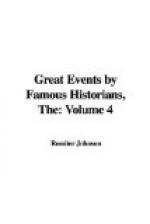exercised the cruelties which, about fourscore years
afterward, were revenged by the son of Clovis.
They massacred their hostages, as well as their captives:
two hundred young maidens were tortured with exquisite
and unrelenting rage; their bodies were torn asunder
by wild horses or their bones were crushed under the
weight of rolling wagons, and their unburied limbs
were abandoned on the public roads as a prey to dogs
and vultures. Such were those savage ancestors
whose imaginary virtues have sometimes excited the
praise and envy of civilized ages!
FOOTNOTES:
[24] In the Nibelungenlied, the old poet who describes the reception of the heroine Chrimhild by Attila [Etsel], says that Attila’s dominions were so vast that among his subject warriors there were Russian, Greek, Wallachian, Polish, and even Danish knights.
[25] If I seem to have given fewer of the details of the battle itself than its importance would warrant, my excuse must be that Gibbon has enriched our language with a description of it too long for quotation and too splendidly for rivalry. I have not, however, taken altogether the same view of it that he has.
FOUNDATION OF VENICE
A.D. 452
THOMAS HODGKIN JOHN RUSKIN
The foundation of Venice (Venetia) is an incident in the history of Attila’s incursions, at the head of his Huns, into Italy after his defeat at the battle of Chalons-sur-Marne. Venetia was then a large and fertile province of Northern Italy, and fifty Venetian cities flourished in peace and safety under the protection of the Empire. After Attila’s remorseless hordes had taken and destroyed Aquileia, near the head of the Adriatic, they swept, with resistless fury, through Venetia, whose cities were so utterly destroyed that their very sites could henceforth scarcely be identified. The inhabitants fled in large numbers to the shores of the Adriatic, where, at the extremity of the gulf, a group of a hundred islets is separated by shallows from the mainland of Italy. Here the Venetians built their city on what had hitherto been uncultivated and almost uninhabited sand-banks. Under such unfavorable circumstances was started the career of that wonderful city which afterward became “Queen of the Adriatic” and mother of art, science, and learning.
The two greatest authorities on Venice are Thomas Hodgkin, who made a life study of Italy and her invaders, and the immortal Ruskin, whose grandly descriptive articles were written in the atmosphere of Venice and the Adriatic Sea.
THOMAS HODGKIN




